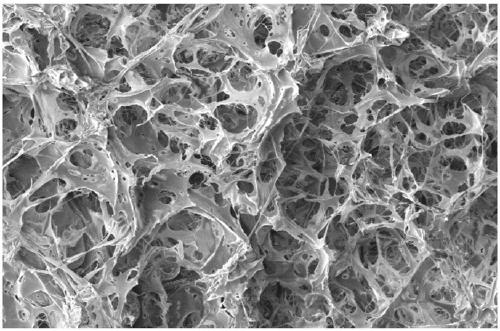Flame-retardant polylactic acid composition and foamed beads thereof
A technology of polylactic acid and composition, applied in the field of flame retardant lactic acid composition and its expanded beads, can solve the problem of poor flame retardant and antistatic properties, influence on molding applications, and control of cell morphology and expansion ratio. problems, etc.
- Summary
- Abstract
- Description
- Claims
- Application Information
AI Technical Summary
Problems solved by technology
Method used
Image
Examples
Embodiment 1
[0112] The raw material ratio and reaction conditions of the flame retardant, flame retardant polylactic acid composition and foamed beads prepared in this example are listed in Table 1 and Table 2, and Table 2 also lists the properties of the expanded beads parameter. In the table, flame retardant component A is phosphine oxide, flame retardant component B is a transition metal salt, and flame retardant component C is an inorganic flame retardant component.
[0113] (1) Preparation of flame retardant
[0114] Add 7 parts by weight of triphenylphosphine oxide and 3 parts by weight of cobalt nitrate into ethanol, stir at a rate of 100rpm, and then use microwave to heat the mixture under stirring. The heating power is 50W, the temperature is 40°C, and the reaction time is 4h. The material after microwave heating reaction is carried out supercritical drying, obtains the complex Co(OPPh of the formation of triphenylphosphine oxide and cobalt nitrate 3 ) 2 (NO 3 ) 2 .
[011...
Embodiment 2
[0135] (1) The preparation method of the flame retardant and (2) the preparation method of the carbon nanofiber antistatic agent are the same as in Example 1, except that the raw material formula and reaction conditions shown in Table 1 and Table 2 are the same. For example, the flame retardant formed in this embodiment is the complex Ni(OPOt) formed by trioctylphosphine oxide and nickel nitrate 3 )2 (NO 3 ) 2 .
[0136] (3) Preparation of polylactic acid base resin PLA102
[0137] The polylactic acid resin is prepared by the following method: in the presence of a catalyst, the cyclic dimer of lactic acid and aliphatic hydroxycarboxylic acid, such as the method of ring-opening polymerization of lactide and glycolide and ε-caprolactone (such as U.S. Patent No. 4 057, the preparation method disclosed in 537).
[0138] The lubricant is a PEG lubricant produced by Clariant, Switzerland, with a number average molecular weight of 10,000.
[0139] Take by weighing 100 parts by w...
Embodiment 3
[0151] (1) The preparation method of the flame retardant and (2) the preparation method of the carbon nanofiber antistatic agent are the same as in Example 1, except that the raw material formula and reaction conditions shown in Table 1 and Table 2 are the same. For example, the flame retardant formed in this embodiment is the complex Co(OPOt) formed by trioctylphosphine oxide and cobalt nitrate 3 ) 2 (NO 3 ) 2 .
[0152] (3) Preparation of polylactic acid base resin PLA103
[0153] The polylactic acid resin is prepared by the following method: a direct dehydration polycondensation method is applied to a mixture of lactic acid, aliphatic dibasic alcohol and aliphatic dibasic acid (such as the preparation method disclosed in US Patent No. 428126).
[0154] The lubricant is a PEG lubricant produced by Clariant, Switzerland, with a number average molecular weight of 10,000.
[0155] Take by weighing 100 parts by weight of the above-mentioned polylactic acid resin, then add a...
PUM
| Property | Measurement | Unit |
|---|---|---|
| electrical resistivity | aaaaa | aaaaa |
| electrical resistivity | aaaaa | aaaaa |
| particle diameter | aaaaa | aaaaa |
Abstract
Description
Claims
Application Information
 Login to View More
Login to View More - R&D
- Intellectual Property
- Life Sciences
- Materials
- Tech Scout
- Unparalleled Data Quality
- Higher Quality Content
- 60% Fewer Hallucinations
Browse by: Latest US Patents, China's latest patents, Technical Efficacy Thesaurus, Application Domain, Technology Topic, Popular Technical Reports.
© 2025 PatSnap. All rights reserved.Legal|Privacy policy|Modern Slavery Act Transparency Statement|Sitemap|About US| Contact US: help@patsnap.com



